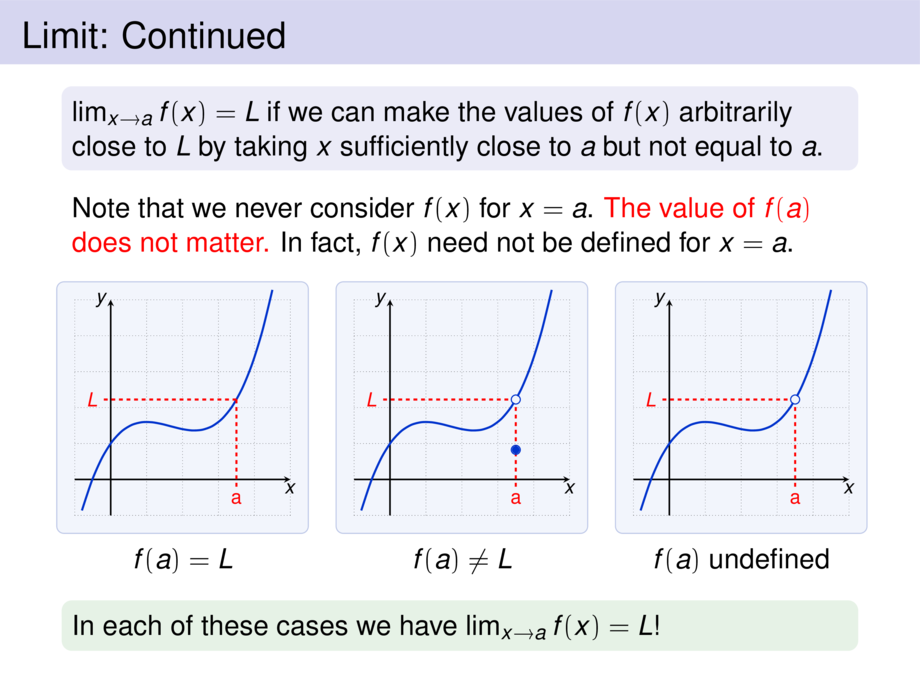



































































































33/154
\begin{frame}
\frametitle{Limit: Continued}
\begin{block}{}
$\lim_{x\to a} f(x) = L$
if we can make the values of $f(x)$ arbitrarily close to $L$
by taking $x$ sufficiently close to $a$ but not equal to $a$.
\end{block}
\medskip
\pause
Note that we never consider $f(x)$ for $x=a$. \alert{The value of $f(a)$ does not matter.}
In fact, $f(x)$ need not be defined for $x=a$.
\bigskip
\pause
\begin{indentation}{-.35cm}{-.5cm}
\begin{minipage}{.35\textwidth}
\begin{center}
\scalebox{.5}{
\begin{tikzpicture}[default,nodes={scale=1.4}]
\diagram{-1}{5}{-1}{5}{1}
\draw[cblue,ultra thick] plot[smooth,domain=-.8:4.5,samples=20] function{.2*x**3 - 1.0*(x+1)**2 + 3.4*x +2};
\def\x{3.5}
\def\y{{.2*\x^3 - 1.0*(\x+1)^2 + 3.4*\x +2}}
\begin{scope}[dashed,cred,ultra thick,inner sep=1mm]
\draw (\x,\y) -- (\x,-2mm) node [below] {a};
\draw (\x,\y) -- (-2mm,\y) node [left] {$L$};
\end{scope}
\end{tikzpicture}
}
$f(a) = L$
\end{center}
\end{minipage}
%
\begin{minipage}{.35\textwidth}
\begin{center}
\scalebox{.5}{
\begin{tikzpicture}[default,nodes={scale=1.4}]
\diagram{-1}{5}{-1}{5}{1}
\draw[cblue,ultra thick] plot[smooth,domain=-.8:4.5,samples=20] function{.2*x**3 - 1.0*(x+1)**2 + 3.4*x +2};
\def\x{3.5}
\def\y{{.2*\x^3 - 1.0*(\x+1)^2 + 3.4*\x +2}}
\begin{scope}[dashed,cred,ultra thick,inner sep=1mm]
\draw (\x,\y) -- (\x,-2mm) node [below] {a};
\draw (\x,\y) -- (-2mm,\y) node [left] {$L$};
\end{scope}
\node[exclude={cblue}] at (\x,\y) {};
\node[include={cblue},yshift=-10mm] at (\x,\y) {};
\end{tikzpicture}
}
$f(a) \ne L$
\end{center}
\end{minipage}
%
\begin{minipage}{.35\textwidth}
\begin{center}
\scalebox{.5}{
\begin{tikzpicture}[default,nodes={scale=1.4}]
\diagram{-1}{5}{-1}{5}{1}
\draw[cblue,ultra thick] plot[smooth,domain=-.8:4.5,samples=20] function{.2*x**3 - 1.0*(x+1)**2 + 3.4*x +2};
\def\x{3.5}
\def\y{{.2*\x^3 - 1.0*(\x+1)^2 + 3.4*\x +2}}
\begin{scope}[dashed,cred,ultra thick,inner sep=1mm]
\draw (\x,\y) -- (\x,-2mm) node [below] {a};
\draw (\x,\y) -- (-2mm,\y) node [left] {$L$};
\end{scope}
\node[exclude={cblue}] at (\x,\y) {};
\end{tikzpicture}
}
$f(a)$ undefined
\end{center}
\end{minipage}
\end{indentation}
\pause\medskip
\begin{exampleblock}{}
In each of these cases we have $\lim_{x\to a} f(x) = L$!
\end{exampleblock}
\vspace{10cm}
\end{frame}

